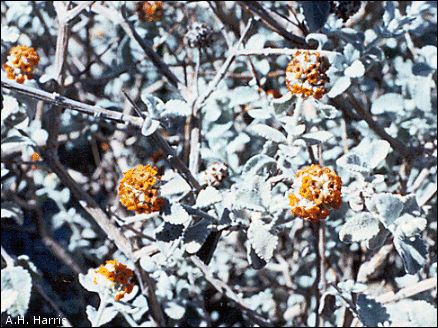

Current bushes produce currents, and raspberry bushes produce raspberries—so butterfly bushes produce butterflies, right? Right! Only not quite in the same sense. Plant a Woolly Butterflybush in your desert garden, and butterflies will appear by the droves—or is it flocks—drawn irresistibly by small balls of flowers. As an additional bonus, the plant, with its distinctive grayish-green coloration, accents nicely the various greens of other desert plants. A dense covering of hairs provides both the grayish tint and the "Woolly" part of the name.
The Woolly Butterflybush is native to the dry mountains in the warmer parts of the Chihuahuan Desert, from the southeastern part of the Trans-Pecos down into Coahuila, Chihuahua, and Nuevo León. At about 5 feet tall, it blends subtly into the pastel landscapes, advertising only by its orange flowers and butterfly-luring scent.
As with so many of our desert plants, this shrub isn't just a
pretty face, but is used medicinally in parts of Mexico, and soaking the flowers
produces a dye that's been used for intensifying the yellow coloration of
butter.

Contributor: Arthur H. Harris, Laboratory for Environmental Biology, Centennial Museum, University of Texas at El Paso.
Desert Diary is a joint production of the Centennial Museum and KTEP National Public Radio at the University of Texas at El Paso.

Flowers and foliage of the Woolly Butterflybush. Chihuahuan Desert Gardens. Photograph by A.H. Harris.
Powell, A. M. 1998. Trees and shrubs of the Trans-Pecos and adjacent areas. University of Texas Press, Austin. 498 pp.
Also see the Chihuahuan Desert Gardens database (search on Woolly).
Basic information.